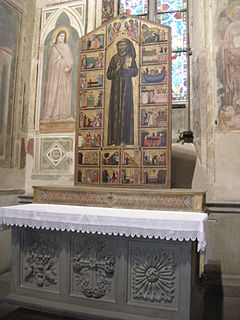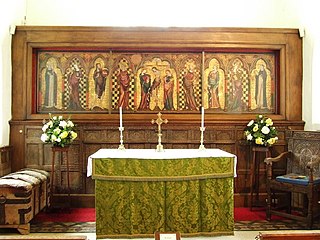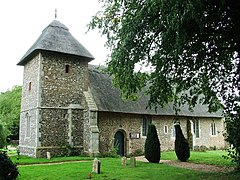
A reredos is a large altarpiece, a screen, or decoration placed behind the altar in a church. It often includes religious images.

Lakenheath is a village and civil parish in the West Suffolk district of Suffolk in eastern England. It has a population of 4,691 according to the 2011 Census, and is situated in the Forest Heath district of Suffolk, close to the county boundaries of both Norfolk and Cambridgeshire, and at the meeting point of The Fens and the Breckland natural environments.

A retable is a structure or element placed either on or immediately behind and above the altar or communion table of a church. At the minimum it may be a simple shelf for candles behind an altar, but it can also be a large and elaborate structure. A retable which incorporates sculptures or painting is often referred to as an altarpiece.

A Dossal, from French dos (back), is one of a number of terms for something rising from the back of a church altar. In modern usage, it primarily refers to cloth hangings but it can also denote a board, often carved or containing a painting, that rises vertically from the back of the altar and to which the cloth is attached. Retable and reredos are alternative terms for solid structures, as is altarpiece, all of them rather more commonly used today.

The Dominican Church, also known as the Church of St. Maria Rotunda, is an early Baroque parish church and minor basilica in the historic center of Vienna, Austria. It is the third church built on the same site in the course of time.

Thornham Magna is the larger sister village of Thornham Parva on the former estate of Thornham Hall, the Henniker family seat, in Suffolk. It is about 3.5 miles (5.6 km) from Eye and close to the A140 road from Norwich to Ipswich.

Siorac-de-Ribérac is a commune in the Dordogne department in the Nouvelle-Aquitaine region of southwestern France.

Stoke-by-Clare is a small village and civil parish in Suffolk located in the valley of the River Stour, about two miles west of Clare.

The Hamilton Kerr Institute is a branch of the Fitzwilliam Museum in Cambridgeshire, England, dedicated to the study and conservation of easel paintings. It is also part of the University of Cambridge.

Little Whelnetham (well-NEE-thum) is a village and civil parish in the West Suffolk district of Suffolk in eastern England. Located around two miles south of Bury St Edmunds, in 2005 its population was 180.

St Dominic's Priory Church is one of the largest Catholic churches in London. The church is Grade II* listed building on the National Heritage List for England. It has been served by the Order of Preachers (Dominicans) since 1861, the community living in the adjacent Priory. In October 2016, the church was solemnly inaugurated by the Cardinal Archbishop of Westminster, Vincent Nichols, as a diocesan shrine, with a designated mission of promoting the Rosary.

Consecration crosses are crosses on the interior walls and exterior architecture of a Christian church or cathedral showing where the bishop has anointed the church with chrism or holy water in order to consecrate it. There is often a place for a candle in front of each cross which is lit on the anniversary of the consecration. The crosses signify the sanctity of the church. The 13th-century Trinity Chapel in Salisbury Cathedral contains a painted consecration cross dating from 30 September 1225.
Blackfriars, Thetford was a friary in Norfolk, England, which belonged to the Dominican Order. It was one of several religious houses in Thetford closed at the time of the Dissolution of the Monasteries. The site is now occupied by Thetford Grammar School.

St Mary the Virgin's Church is a redundant Anglican church in the village of Stonham Parva, Suffolk, England. It is recorded in the National Heritage List for England as a designated Grade I listed building, and is under the care of the Churches Conservation Trust. The church is sited 10 miles (16 km) north of Ipswich, to the west of the A140 road.
Linstead Magna is a civil parish in the East Suffolk district of Suffolk in eastern England.
Linstead Parva is a small village and civil parish in the East Suffolk district of Suffolk in eastern England. It has a small but notable 13th-century parish church, still in regular use. The village pub, The Greyhound, was already established and trading when referenced in 1874, but it closed permanently in March 1955, and is now a private dwelling.

North Cove is a village and civil parish in the north of the English county of Suffolk. It is part of the East Suffolk district, located around 3 miles (4.8 km) east of Beccles and 5 miles (8.0 km) west of Lowestoft. It merges with the village of Barnby and the villages share some resources, although the two parishes retain separate parish councils.

St Mary's Church is a medieval church in Thornham Parva, Suffolk, England. Much of the fabric dates from the 12th century, and it is a Grade I listed building. Originally the church served not only Thornham Parva but the neighbouring village of Thornham Magna, which is now a separate parish.

The Thornham Parva Retable is a medieval altarpiece, now in Thornham Parva, Suffolk, England. The retable is thought to have been created in the 1330s for a Dominican Priory. At 15 feet (4.6 m) long, it is the largest surviving altarpiece from the English Middle Ages.

















